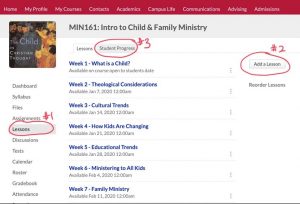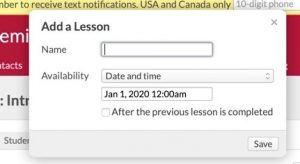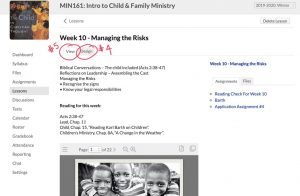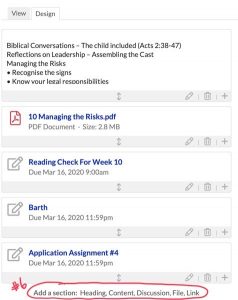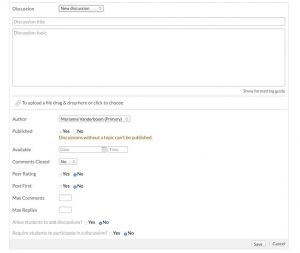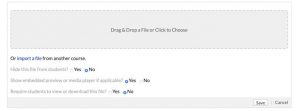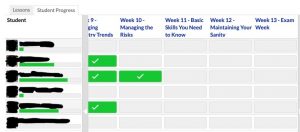The Big Picture
The mission of Heritage Baptist College is to provide an evangelical, faith-based, university-level education to equip students for life and service in the church, community, and the world.
Every certificate and degree we teach at Heritage seeks to fulfill that mission. Further, each certificate and degree we teach has its own mission: to prepare students for pastoral ministry, or youth ministry, or intercultural ministry, for example. Each course has been created to fit into that bigger picture.
So, the course you are teaching already has a course description, which gives a broad-strokes explanation of what that course is about. This ensures that the course will fit into the bigger picture as it should. What exactly is taught, how it is taught, and how it is evaluated is entirely up to you as the course’s professor. Those are the elements you will be creating in the syllabus.
The syllabus is a legal document between the professor and the students. Once it has been submitted and posted, it cannot be changed without the consent of the students in the class. Further, it is the professor’s obligation to follow the syllabus to the very best of his or her ability.
This document will help you to craft a helpful syllabus.
Elements of the Syllabus
This section will walk you through the syllabus elements and how best to complete them.
- Instructor: Fill in your name (and possibly how you wish to be addressed), and when and how you are available for consultation. We do not recommend giving students your private email or cell phone number. Please use a Heritage email, and if you wish for students to be able to text you, sign up for text notifications on myHeritage and tell them they can text you via myHeritage. This provides privacy protection for both you and the students.
- Course description: Copy the course description as it is found on myHeritage. Please do not alter it without first contacting the Dean. This ensures that the course will appropriately fit into the bigger picture of Heritage’s academics.
- Course objectives: The objectives will list the specific learning outcomes you wish students to achieve by the end of the course. To ensure a holistic education, objectives should cover cognitive aspects of the material (knowledge-based outcomes), affective aspects (character and attitude-based outcomes), and psychomotor aspects (skills-based outcomes). Objectives should be specific and directly measurable through the assessment measures. That is, if you indicate you want students to know something, you need to clarify how you will know that they know.
- Course texts: The books you choose as course texts are up to you. Remember that Heritage is providing a university-level education, so texts should be sufficiently advanced, but books written at the lay level are also appropriate. Texts should be readily available, and we do try to to keep textbook costs somewhat reasonable. One very expensive text is fine, but three for one course are probably not. A textbook does not need to cover the entirety of the material of the course, but should contribute in some way to fulfilling the objectives. Readings other than textbooks are permitted, but would not be listed under textbooks unless they are resources that students are expected to procure on their own.
- Writing Style and Syntax: This section is standard for all syllabi.
- Confidentiality and Records: This section is standard for all syllabi.
- Course Requirements:
- Requirements regarding attendance, course evaluations, and library resources are standard for all syllabi. Other course requirements can be changed. If you wish to allow or disallow cell phones, tablets, laptops, eating or drinking, etc, or you have other requirements not listed, you can add them to this section of the syllabus.
- Readings: Specify here when you expect reading to be done by (before class begins or after class), and whether or not there will be additional reading beyond that of the listed class texts. If you have additional reading, indicate approximately how many pages of additional reading students can expect.
- Assignment submissions: Indicate here what your policy is regarding how assignments are submitted, when they are due, and any extension policy you set. Please note that assignments submitted late without any prior extension agreements must be penalised with at least 10% reduction in the final grade per 24-hour period, but can be penalised with a reduction of up to 100% in the final grade (essentially a grade of 0 for any late assignment). In addition, you are not expected to grant extensions except in extenuating circumstances, nor do we encourage a lax policy for extensions and late submissions. Please make and follow through with the policies you set here. Assignments can be submitted by hard copy, by emailing files to the professor, or by uploading them to myHeritage. Clarify in the syllabus which you would prefer.
- Course assignments: Here, you will outline your assessment methods. For each assessment method, you will want to specify the kind of assignment/title, its due date, its percentage of the overall mark, and a description which will help students to see how this assignment is evaluating the objectives listed earlier. A few pointers below will help in creating course assignments:
- First-year courses (100 course codes) should rely more heavily on quizzes, tests, and exams than on research and writing. Upper classes should rely more heavily on research and writing, and may not include exams at all, unless that is deemed the most effective way of measuring the objectives.
- No single assignment should be worth more than 40% of the final grade.
- Assignments should be spread somewhat evenly throughout the semester so that students are able to evaluate their progress by mid-term.
- Assignments should be weighted according to the time taken to complete them.
- The more clarity you can provide students regarding expectations of assignments, the better students will do and the fewer questions they will ask. At minimum, specify word count and a description of the topic.
- Anticipated workload: This allows students to see how they should be managing their time in the course, and ensures that the course is rigourous enough without being too rigourous for a university level. Add up all the numbers. To be a suitable workload for a university-level course, you should have approximately 80 hours of work in total for the semester.
- In the chart, under the readings, list all the reading (including texts and articles) that students will be doing, including the number of pages in each. Count on one minute per page, and figure out how many hours each reading will take.
- Under quizzes and exams, list all quizzes and exams students will be taking, and estimate how long it will take for students to prepare for each.
- Under assignments, list all assignments the students will be writing and provide a number of hours each will take. For writing that does not require any research, figure on approximately 30 minutes per page. For writing that does require research, figure on approximately 1-1.5 hours per page, depending on the level of research required.
- Level of achievement: This is standard to all syllabi.
- Course schedule: Students rely heavily on this section of the syllabus to keep track of what they have to do and what to expect for the class. When a topic is listed in the syllabus and that is then not covered, they struggle to follow. Remember, the syllabus is a contract between professor and student. This schedule helps students to see the coherence of the course and to be assured that objectives are being covered appropriately.
- In the Date column, list the dates for the semester. Include dates for special events on which you may not have class, such as stat holidays, Missions’ Conference or Reading Weeks. You will find these dates on myHeritage and in the email that the administrative assistant sent to you.
- In the Topic column, list a brief description of what will be covered in the week’s lecture. If there is no class due to a special event, write, No Class. If you have a special speaker coming in, include that.
- In the Reading column, list what reading is due for that class. Include book title and chapter, or the title of any articles.
- In the Assignments column, list whatever assignments are due that week. If you have an assignment that is due each week (such as a summary of reading), then list it every week.
When You’re Done
Congratulations! You wrote a syllabus! Now what?
You received an email from the administrative assistant which contained a link to a Sharepoint folder. Upload your new or revised syllabus to that Sharepoint folder on or before the date syllabi are due.
From here, your syllabus will be checked to ensure that it is complete and correct. When it is so, the updated copy will be uploaded to your course page on myHeritage. This version will become the official and binding copy of the syllabus. Your students will be able to download it and print it from there.
At the beginning of the first class, you should go over the syllabus with your class to ensure that they are familiar with it, and to give opportunity for any questions they may have.

